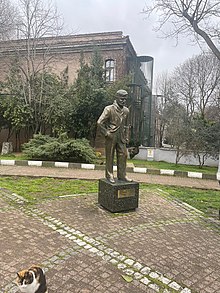Özdemir Asaf
Özdemir Asaf | |
|---|---|
 Statue of Asaf by Namık Denizhan in the Şairler Sofası Park | |
| Born | Halit Özdemir Arun June 11, 1923 Ankara, Turkey |
| Died | January 28, 1981 (aged 57) Istanbul |
| Occupation | Writer, poet |
| Language | Turkish |
| Nationality | Turkey |
| Education | Galatasaray High School Kabataş High School Istanbul University |
| Spouses |
|
| Children |
|
| Relatives | Mehmet Asaf (father) |
Özdemir Asaf (11 June 1923, Ankara – 28 January 1981, Istanbul) was one of the prominent Turkish poets during the early Republican period.[1]
In 1941, when he was in the 11th grade, he entered Kabataş Erkek High School with an additional exam and graduated in 1942. He studied for a year at the Faculty of Law, Faculty of Economics (until the 3rd grade) and Faculty of Journalism. Meanwhile, he worked for Tanin and Zaman newspapers and made translations. His first article appeared in Servet-i Fünûn (Uyanış) magazine. He founded Sanat Basımevi in 1951 and published his books under the name Yuvarlak Masa Yayınları. He was among the founders of the Basic Life Association, which was established in 1962 under the leadership of Mehmet Ali Aybar.[8] Özdemir Asaf, who died on January 28, 1981, had a daughter named Seda from his first wife, Sabahat Selma Tezakın; He has three sons, Gün, Olgun and Etkin, from his second wife Yıldız Moran. Özdemir Asaf, who first contracted lung disease and then was diagnosed with a tumor in his brain, passed away in Bebek on January 28, 1981. The name Özdemir Özden was first used for Özdemir Asaf, who could not pronounce the 'R's'. Later, with the idea of Oktay Akbal, he chose his father's name Asaf instead of Özden and changed it to Özdemir Asaf.
Biography[edit]
Life[edit]
He was born on 11 June 1923 in Ankara. His real name is Halit Özdemir Arun. His father, Mehmet Asaf, is one of the founders of the Council of State.[2] In 1930, the year his father died, he entered the first part of Galatasaray High School.[3] In 1941, in the 11th grade, he went to Kabataş High School for Boys with an additional exam and graduated in 1942. He attended the Faculty of Law, the Faculty of Economics (until the 3rd grade), and the Faculty of Journalism for one year. Meanwhile, he worked for Tanin and Zaman newspapers and made translations.[4]
Career[edit]
His first article published in Servet-i Fünun (Uyanış) magazine. He is founder of Sanat Basımevi (1951) and published his books under the name of Yuvarlak Masa Yayınları. He became one of the founders of the Temel Hakları Yaşatma Derneği (Fundamental Rights Survival Association), which was founded in 1962 under the leadership of Mehmet Ali Aybar.[5]
Together with Attila İlhan, he was the most loved poet of the literary matinees, which was the favorite activity of the 1950s.[5] Özdemir Asaf, who visited the coastal cities of the Atlantic and the east of America in 1954, traveled almost all of Europe, starting from Lapland in 1959. In 1966, at the invitation of the Macedonian Writer's Union, he went to Yugoslavia and participated in the poetry congress.[2]
Bibliography[edit]
Poems[edit]
|
Ethica[edit]
Story[edit]
Essay[edit]
Translations[edit]
|
|
A poem of Özdemir Asaf – Lavinia (1957)[7]
Turkish
Sana gitme demeyeceğim.
Üşüyorsun ceketimi al.
Günün en güzel saatleri bunlar.
Yanımda kal.
Sana gitme demeyeceğim.
Gene de sen bilirsin.
Yalanlar istiyorsan yalanlar söyleyeyim,
İncinirsin.English
I won't ask you not to go.
You are cold, take my jacket.
These are the loveliest times of the day.
Stay with me.
I won't ask you not to go.
Still, you know.
If you want lies, I will tell you lies,
You'll be hurt.
References[edit]
- ^ Sözlüğü, Türk Edebiyatı İsimler. "Özdemir Asaf". teis.yesevi.edu.tr. Retrieved 28 August 2021.
- ^ a b Sözlüğü, Türk Edebiyatı İsimler. "Özdemir Asaf". teis.yesevi.edu.tr. Retrieved 28 August 2021.
- ^ "Özdemir Asaf Şiirleri – Şair Özdemir Asaf". Antoloji.com (in Turkish). Retrieved 28 August 2021.
- ^ "Özdemir Asaf Yazarı ve Denemeciliği" (PDF).
- ^ a b Mehmet Ali Aybar (2014). Kıvanç Koçak (ed.). Türkiye İşçi Partisi Tarihi. İletişim Yayınları. pp. 84–87.
- ^ "1744.Seçme Şiirler\Özdemir Asaf-Editions Bleu Autour". teda.ktb.gov.tr. Retrieved 28 August 2021.
- ^ "PROFILE – Ozdemir Asaf: A gentle poet". www.aa.com.tr. Retrieved 29 August 2021.
- (8) Mehmet Ali Aybar (2014). Kıvanç Koçak (Ed.). Türkiye İşçi Partisi Tarihi. İletişim Yayınları. s. 84-87.
